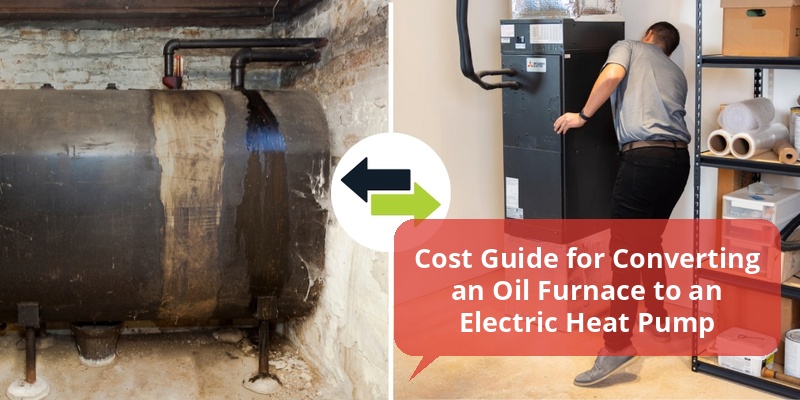Converting an oil furnace to an electric heat pump system is an increasingly popular option for homeowners seeking energy efficiency and environmental benefits. This conversion can reduce energy costs, lower carbon emissions, and improve home comfort. However, understanding the costs involved in this transition helps homeowners make informed decisions. This article provides a detailed breakdown of expenses, factors influencing the overall cost, and tips to maximize your investment in switching from oil furnace heating to electric heat pumps.
| Cost Component | Estimated Price Range |
|---|---|
| Heat Pump Unit | $3,500 to $7,000 |
| Installation Labor | $2,000 to $5,000 |
| Removal of Oil Furnace | $500 to $1,500 |
| Electrical Upgrades | $1,000 to $3,000 |
| Additional Components/Permits | $500 to $1,500 |
| Total Estimated Cost | $7,500 to $18,000 |
Factors Influencing the Cost of Converting from Oil Furnace to Heat Pump
Multiple factors affect the overall conversion cost. The size of the home and the heating load are crucial in determining heat pump capacity requirements. Larger homes or those with poor insulation often need more powerful systems, pushing costs higher.
The condition and age of existing electrical wiring can also impact expenses. Older homes might require electrical panel upgrades to support the heat pump system’s energy demands. This can add significantly to the cost.
Removal and disposal of the old oil furnace may also vary based on the unit’s size and complexity. Additionally, local regulations could require permits or specific equipment standards, further influencing the price.
Climate zone plays a role, too—cold northern climates may require more advanced heat pump technology (like cold climate heat pumps), which typically cost more upfront.
Heat Pump Unit Cost Explained
The primary expense in converting to electric heat is the cost of the heat pump unit itself. Prices range widely depending on type and capacity.
- Air-Source Heat Pumps: Most common, typically $3,000 to $7,000. Suitable for moderate climates.
- Cold Climate Heat Pumps: Designed for subzero temperatures, these units cost $5,000 to $10,000 but offer better efficiency in cold weather.
- Ground-Source (Geothermal) Heat Pumps: Highest upfront cost, ranging from $10,000 to $25,000. Installation is labor-intensive but offers superior efficiency and longevity.
Selecting the right type ensures optimal performance without overspending.
Installation and Labor Costs
Professional installation is critical for reliable operation and maximizing efficiency. Labor costs vary by region but average between $2,000 and $5,000. This includes:
- Mounting and connecting the heat pump system
- Integrating with existing ductwork or installing new ductwork if necessary
- Electrical system connection and upgrades
- System testing and commissioning
Complex installations, such as those requiring ductwork modifications or electrical panel replacements, can push costs toward the higher end.
Costs for Removing the Oil Furnace
Old oil furnace removal and disposal typically cost $500 to $1,500 depending on size and location. Costs include:
- Safe disconnection of fuel lines and electrical wiring
- Removal and transportation
- Disposal fees and environmental compliance
Some oil furnaces might contain hazardous materials like asbestos, which can increase removal complexity and cost.
Electrical Upgrades and Associated Expenses
Heat pumps generally require substantial electrical capacity. Many homes with oil furnaces lack sufficient electrical infrastructure, leading to necessary upgrades in:
- Service panels
- Wiring and circuit breakers
- Dedicated circuit installations
Estimates for these upgrades typically range from $1,000 to $3,000 but can vary widely based on home condition and local electrical codes.
Additional Components and Permit Fees
Permits, system accessories, and contingency costs add to the total investment. These may include:
- Permitting and inspection fees
- Thermostats and control systems
- Refrigerant charging and leak testing
- Minor ductwork sealing and insulation
This category often adds $500 to $1,500 depending on project scope and local regulatory requirements.
Long-Term Savings and Incentive Programs
Although upfront costs are significant, electric heat pumps reduce energy bills substantially by providing efficient heating and cooling. Many states and utility companies offer rebates, tax credits, and incentives that can offset installation costs.
Typical programs include:
- Federal tax credits for energy-efficient HVAC systems
- State-level rebates for heat pump installations
- Utility company incentives for electric heat adoption
Researching available financial support is critical to minimizing out-of-pocket expenses and accelerating return on investment.
Evaluating the Conversion: Cost vs. Benefits
Conversion from oil furnaces to electric heat pumps can offer significant environmental and cost benefits but requires careful evaluation of:
- Initial investment and financing options
- Home insulation and retrofit needs
- Energy price trends and climate suitability
- Available incentives and rebates
Consulting with HVAC professionals and energy auditors helps determine the most cost-effective solution tailored to individual homes.
